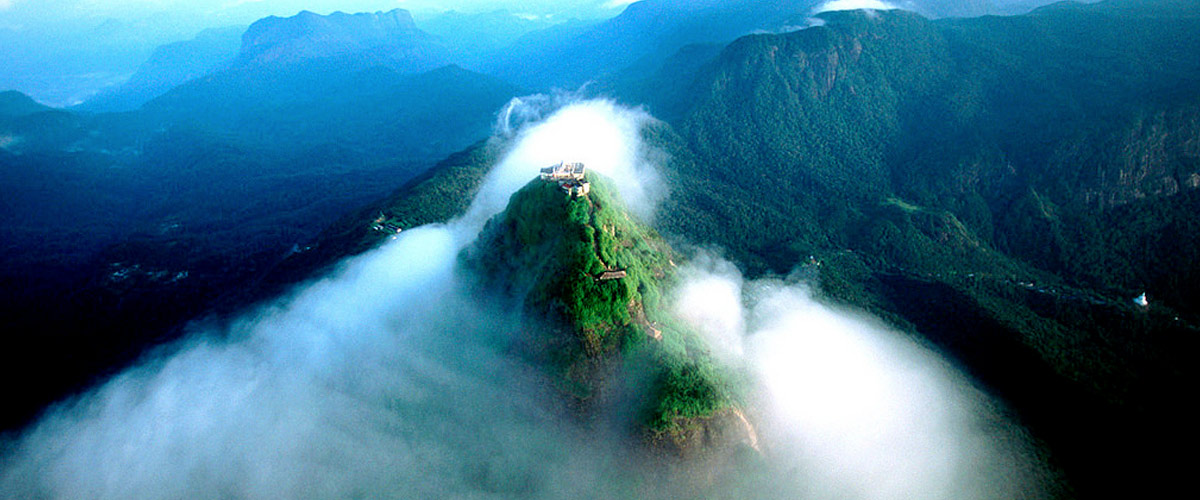Elite Artisan tea producers maintain many advantages over the large Agribusiness lowland farms that make commodity machine-processed ingredients for bags, ready-to-drink and iced teas. These start with the old cliché about real estate prices being set by Location, Location, Location. They can create a tea of such pedigree that it commands a price premium and quality identification. Here is tea location at its literal peak.
Adam’s Peak, in Sri Lanka, where some of the most outstanding tea is grown. It seems somewhat unlikely that machines will at any time be mulching their way up the 60 degree slopes where the tea is grown.
Adam’s Peak makes white tea of an extraordinary quality. Some obvious questions about it apply to Artisan teas in general, including the emerging superb whites of Darjeeling, where Castleton Moonlight may well be the world’s top-rated, Ceylon’s highland whites, and Taiwan’s Shan oolongs:
How much tea does it produce?
Very little. Annual production is limited to 3,000 pounds, which is enough to make less than two thousand cups a day. It’s very much a specialty tea. It was the first white tea to be made outside China and remains the rarest and highest rated. There are other such Silver Needle teas of outstanding quality but this one is location-defined, location-constrained in terms of production and distribution and location-unique.
What makes it distinctive?
The extreme selectivity of the buds picked at the exact right time and the exquisitely careful preservation of their nutrient-rich freshness and flavors. Great care is taken to avoid any damage or bruising to a leaf, even down to how the bud is snapped from the branch.
A near-cliché in descriptions of white tea is that it is ideally harvested early on a bright sunny morning when the sun is high enough to have dried off any traces of moisture on the leaf. It is a minimalist tea in the sense that only the purest, freshest and most tender buds are used and nothing done to break them up, heat them or reshape them. Delicacy is all.
Is it expensive?
Yes. Around four to six times the cost of other pedigree white teas. It’s over $400 a pound, with prices fluctuating wildly, often because of the disruptions to transportation created by Sri Lanka’s brutal civil war (now sort of settled), outlaws and armed gangs. It’s one of the most expensive teas on the regular market. Even so, the price per cup is about $2 and it can be infused –resteeped – at least three times.

Is it worth it?
Maybe, maybe not. It’s not a tea to try if you are unfamiliar with light whites or strongly prefer full black ones. Some drinkers find it too watery. Others love its fusion of just a touch of sweetness, a surprising fullness, and lingering aftertaste. Whether or not you want to spend the $2 a cup for it, it’s your choice. You can pick a top rate white Silver Needle instead, for 50 cents or a good White Peony for 30¢.
Adam’s Peak white tea is at the extreme on answers to each of these four questions, but they apply across all teas, from the lowest quality bag on up. Here’s a summary of the two paths:
Artisan: How much? A little volume but many varieties. What makes it distinctive? The same general factors that make for a great restaurant dish. How expensive? Far less than you may assume up to far more than you would ever consider paying for a drink. Is it worth it? Oh, yes.
Agribusiness: How much? The supply is higher than the world demand. What makes it distinctive? The name and associations, marketing and health pitches. There is nothing distinctive about the tea ingredient(s). How expensive: More than you may assume, down to cheap but barely drinkable. Is it worth it? Well, sorta, kinda, maybe, it’s cheap… So: No. You can do much better with Artisan teas.


1 Comment
Hi, this is a very nice article. I’ve tried the white teas you’ve mentioned in the article and they were from Sri Lanka. The taste was quite different, I actually enjoyed it, but as you’ve mentioned, it is not for everyone.